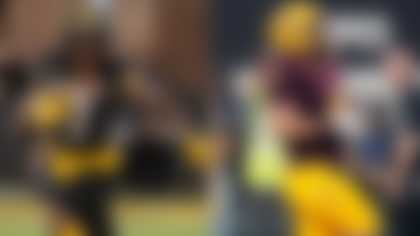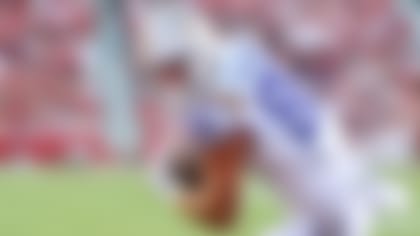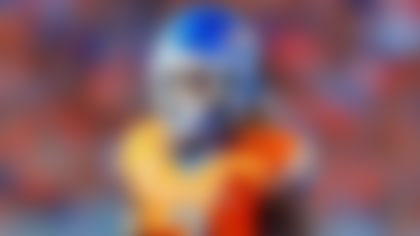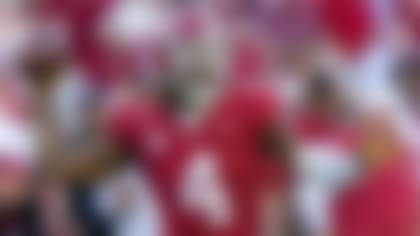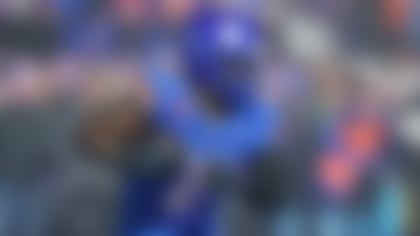NEW YORK -- When the NFL hurriedly approved a new rule in March to create a foul for any player, anywhere on the field, who lowers his head to initiate and make contact with his helmet against an opponent, it was motivated by concern over the rise in concussions last season.
But the league moved so quickly to make the new rule that the language was not finalized, the use of replay was not confirmed and even coaches and league officials were unsure about how it would be officiated. On Tuesday, the NFL began a two-day meeting to iron out the new rule and help coaches to start educating players, a how-the-sausage-gets-made session to figure out what the league hopes will be a significant step in reducing concussions.
On Wednesday, the league will address potential changes to the kickoff, long considered the most dangerous play in the game. Troy Vincent, the NFL's top executive for football operations, said Tuesday morning that the league will not eliminate the kickoff, and does not want to make it into just a "ceremonial" play. But the league will look to modify the kickoff to make it safer in time for the 2018 season. He hopes to emerge from Wednesday's session with a rules proposal that owners can vote on at their meeting later this month.
But Tuesday's session was devoted to the new helmet rule. The takeaway: This is very much still a work in progress, but one that is potentially transformational for the game. The object, repeated over and over on Tuesday, is to get the head out of the game as much as possible. That, everyone concedes, it likely to take some time. Vincent said that after 41,000 plays from 2017 were reviewed, he expects just a handful of ejections resulting from this rule per season and likely five or fewer fouls being called per game for the new rule.
Rich McKay, the chairman of the competition committee, compared the implementation of this new rule to the mid-1990's, when the league put in the defenseless player rule. When that rule was first installed, McKay said, officials struggled to know when to call it and players and coaches struggled to understand what they were allowed to do. During games, McKay said, officials missed a lot of fouls, and the league wound up instead fining players after the fact. But over time -- McKay said it took about three years -- everybody adjusted and he said the league has now more than 90 percent accuracy in calling defenseless player penalties. McKay expects the same adjustment period for the helmet rule, which will be a 15-yard penalty, and which will include the possibility of ejection for the most egregious cases. Preseason games this summer are likely to be feeling out periods, but Vincent expects that about three weeks into the season, players and officials will have a better understanding of how the rule will be called this year.
The build up, as frustrating as it might be for fans, is a relief for coaches.
"Thank God," said Los Angeles Chargers coach Anthony Lynn of the expected adjustment period. "Because I just felt like after we left the owners meeting, we were just jumping into this thing head first. Whoa, slow down. Do this in phases. It's going to be very educational process for our players and for our coaches. Our players, once we bring them this data, show them video clips, they'll make the adjustment. But it's going to take time."
How much adjustment will it take? During the sessions that included about 40 coaches, former players, game officials and league executives, McKay and Al Riveron, the head of officiating, disagreed while watching a play that involved running back Dion Lewis lowering his head to hit a defender about whether Lewis would be called for a foul under the new rule. McKay insisted that the play should be penalized, but the lack of consensus underscores a central issue the league will face -- if league officials aren't sure, how can anyone else be?
That was part of what this session was for -- to educate coaches about the culture shift the league hopes for, so that they can carry the lessons back to players who have already begun off-season workouts. There is little doubt this will be difficult, particularly for mid-career players who have used their heads to make contact most of their playing lives. There was discussion, for instance, about getting running backs to use their shoulder pads rather than their helmets to make contact with a defender in the open field. And to emphasize to interior linemen the need to get their hands up rather than lead with their heads. Lynn talked about the need for new teaching techniques to trickle down to youth football, where players first learn their techniques.
More immediately, the group worked on finalizing the language of the helmet rule, particularly about what will constitute a foul worthy of ejection. The league hopes to have that language finalized in about a week so that it can be circulated to the competition committee and to coaches. And the portion of the rule involving the use of replay -- all ejections must be reviewed by the officiating command center in New York -- still must be approved by owners later this month.
"I'm close to 90 percent clear and the thing keeping you up at night is the way to get it taught to each position," said Falcons coach Dan Quinn. "How does this rule effect a running back, an offensive guard who is pulling, a defensive back."
Several coaches asked the league to make video cut-ups of plays that will now be fouls, to be voiced over by coaches, not league executives, so that when training camp opens they can show each position group examples of how they want the players to hit. Others asked on behalf of players for a grace period for fines as players adjust, and the league is likely to issue warning letters instead of fines during the preseason. Coaches also harped on a familiar topic -- the decreased amount of practice time, particularly in pads, giving them little opportunity to teach new techniques. Not surprisingly, some coaches expressed skepticism about whether officials will throw the flag on an offensive player who just made a big gain.
"The Dion Lewis play, he's in a triangle," Lynn said. "You have to teach the running back to split through. There have been times you say attack the guy -- as coaches we have to change how we coach, how we teach. We have to understand the game is changing as well."
"I think the biggest adjustment will be to defensive players. A lot of times we point fingers at defense, but it's offense, too. We have to teach it on both sides of the ball."
There is still much to sort out. Part of the afternoon was devoted to interior line play and how the new rule will be enforced. Steelers coach Mike Tomlin, a member of the competition committee, acknowledged that calling the helmet foul on interior linemen will be especially difficult, because it will be hard for officials to see through so much traffic on the lines, and perhaps even more difficult for players making contact in such a small space to avoid lowering their heads. Changes on the interior line, Vincent acknowledged, will likely take longer to implement than those in space, simply because the fouls -- and the techniques that need to be changed -- are so much harder for officials to spot.
"If we see illegal contact, it's a foul," Riveron said. "Some are harder to see than others."
However, game officials will be instructed to make sure it is a foul before throwing a flag -- in other words, they will be conservative, at least initially, in enforcing the new rule. And while the new rule allows for ejection in the most egregious cases, officials in New York will not eject a player if the on-field officials did not call for the ejection. The league does not anticipate more than three or four ejections per season under the new rule.
Still, as much concern as there was for the nitty-gritty of officiating the rule and how to teach players, there was consensus that hits to the head need to be minimized. Quinn said he hoped that in years to come, coaches will be allowed to have more practice time with players so they can teach new techniques, although that seems an unlikely concession from the players union, which views reduced practice time and more rest as a key element of player health. And there was a suggestion that at the scouting combine next year, offensive line and defensive line coaches should be brought together, so they can learn what the expectations are for interior line play and what the league wants out of the game.
"How will we measure how we're improving?" Quinn said. "You better have some measurement for it. For this, what's going to be our measurement for the enforcement of ruling making a significant difference. For us, probably the injuries."
Follow Judy Battista on Twitter @judybattista

